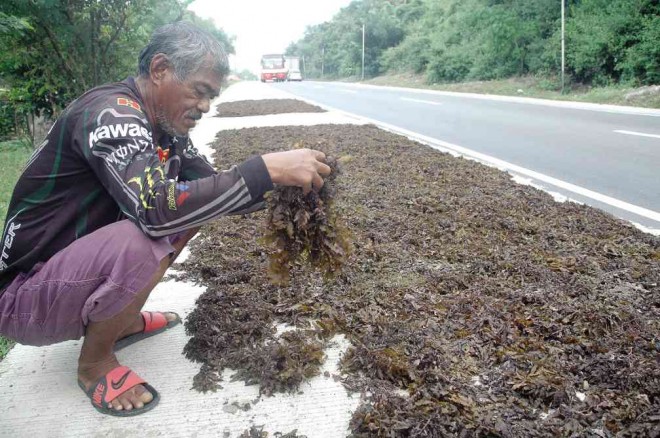Overharvesting perils seaweeds

SEAWEED gathering has become an alternative livelihood for fishermen, like Cristobal Ibasan, in San Fabian town in Pangasinan province. Ibasan dries seaweeds on the concrete shoulder of the highway in San Fabian. RAY ZAMBRANO
Passing through the highway traversing Alacan village in San Fabian town in Pangasinan province, one cannot ignore the peculiar smell of seaweeds being dried by fishermen by the roadside.
Seaweeds harvesting has spurred alternative economic activities in this coastal town.
“The villagers have been gathering seaweeds even when I was a boy,” Cristobal Ibasan, 61, said as he flipped over the seaweeds he was drying.
What’s on the pavement is sargassum, a brown or dark green seaweed, which local buyers said are used as ingredient for animal feed or fertilizer.
During “daleg,” or when the waves are big, large quantities of sargassum are carried to the shore where they are easily gathered by residents. On ordinary days, however, fishermen travel about a kilometer and dive into the sea to harvest them.
Article continues after this advertisementThere are times when it is not possible to gather seaweeds like when the water is murky. There is also the danger of getting hurt by corals or getting stung by jellyfish, fishermen said.
Article continues after this advertisementOn a good day, Ibasan said he could gather up to 30 kilograms of sargassum. “It is difficult to gather the seaweeds and to dry them but we don’t really earn much as the price is
only P4 a kg,” he said.
But Dr. Gavino Trono, professor emeritus of the University of the Philippines’ Marine Science Institute in Bolinao town and an expert on seaweeds, said local fishermen should earn more as there are many uses for sargassum.
“Sargassum is used as raw material for many high-priced products like cosmetics and medicine and in textile manufacturing. The fishermen are losing, and we and the environment are paying the high price because the seaweeds are getting depleted because of overharvesting,” he said.
The Bureau of Fisheries and Aquatic Resources (BFAR) in the Ilocos region has tapped Trono to train fishermen on seaweeds farming in Bolinao, where a farm will be established by the agency.
Big demand but…
There is a demand for seaweeds, he said, adding that he had been approached by a Chinese businessman who wanted a supply of 1,000 tons of sargassum every month. “Where will we get that volume of seaweeds without depleting our resources?” he said.
Trono said fishermen harvest sargassum by uprooting them and this could lead to the seaweeds’ depletion.
He said it takes a year before the seeds (also called embryo) grow into mature plants, calling the process “fresh annual growth.” If fishermen cut or prune the fronds, these will grow back soon and the seaweeds will not be depleted, he said.
Regulate harvest
Trono said the country should regulate the harvest of seaweeds.
“I think there is a need to stop harvesting and study how to conserve at the same time use this precious sea resource. [BFAR Director Asis Perez] is issuing a memo about stopping sargassum harvesting in the country,” he said.
Ibasan said Alacan residents had lost a variety of edible seaweeds, locally known as “ararosep” (Chlorophyta), due to overharvesting.
Perhaps learning a lesson, residents avoid overharvesting the variety “culot” (Laurenciapapillosa), which, he said, tastes good when cooked with tamarind.
“We cut the tips. We don’t waste them,” he said.
But he said other varieties, collectively called “tamsaw” by residents and which they gather some 5 km from the shore using gill nets, are extensively harvested.
These varieties are Eucheuma spinosum, Gelidiella acerosa, Kappaphycus alvarezii and Kappaphycus striatum.
“They are made into jelly. They are more expensive at P10 a kg, but we have to use a motorboat to go far into the sea where they thrive,” Ibasan said.
These species are sources of gel or carrageenan, Trono said. It is the Eucheuma spinosum variety which the BFAR is introducing to Bolinao waters.